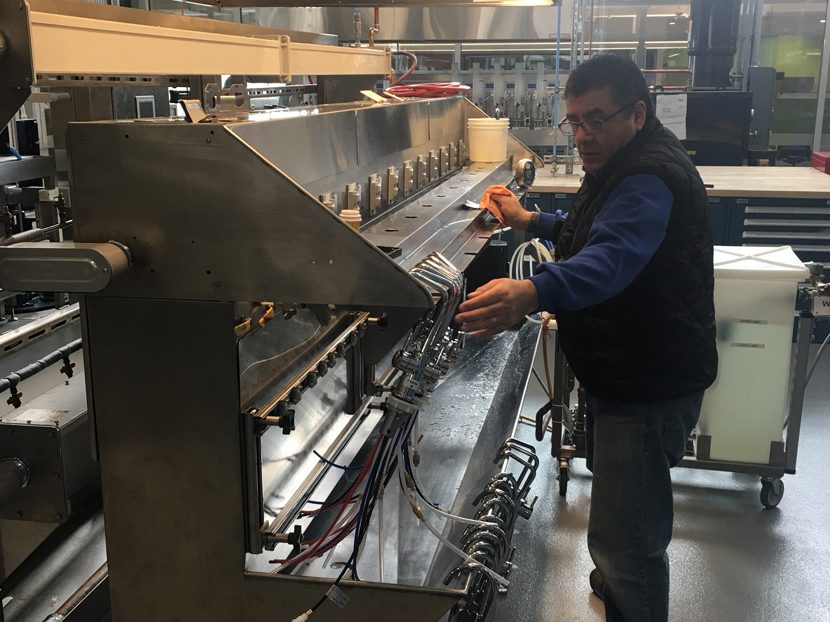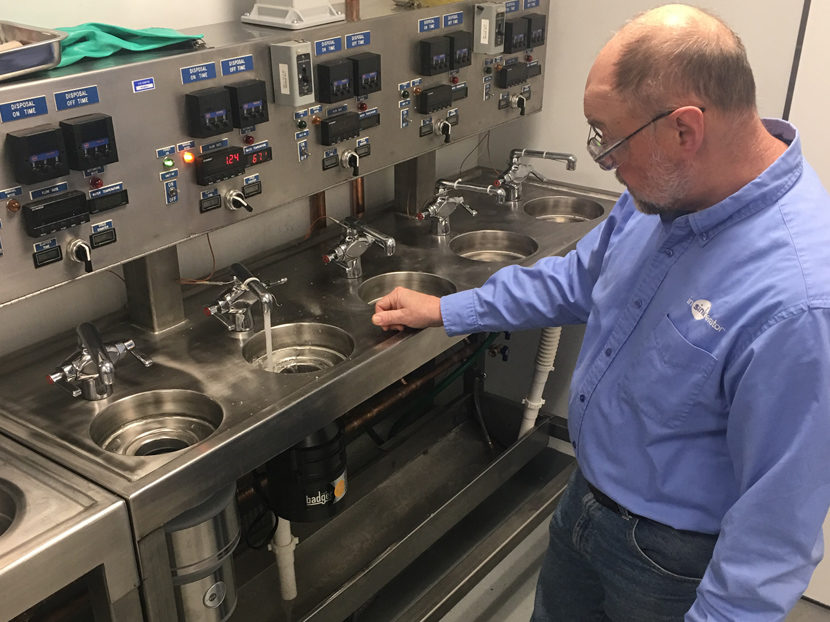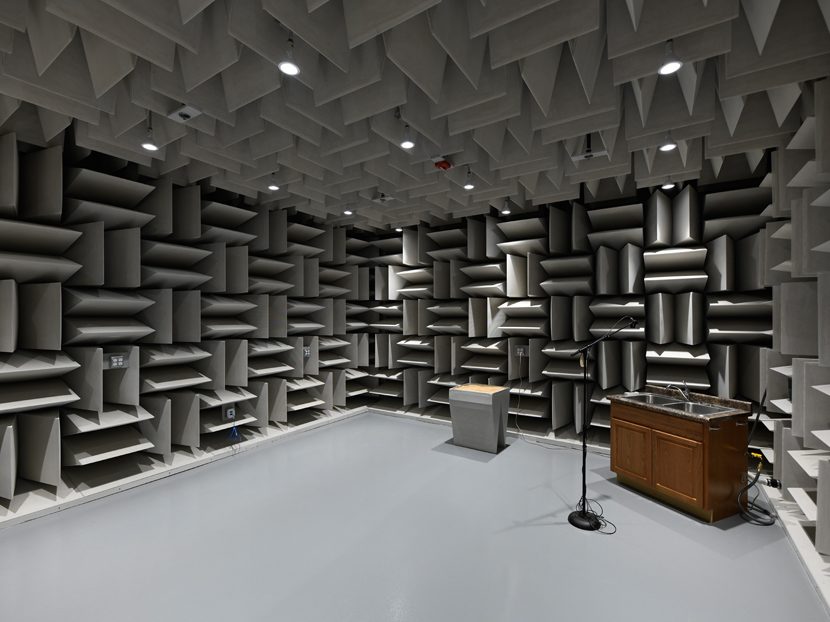InSinkErator Opens New Headquarters
New building is part of a multimillion-dollar investment in the company’s longtime Southeastern Wisconsin base.












Toward the back of InSinkErator’s new gleaming steel-and-glass headquarters in Mount Pleasant, Wisconsin is what must be the world’s quietest kitchen. There, visitors will spot an ordinary, everyday kitchen sink complete with backsplash inside what looks like a recording studio with baffled walls and ceiling.
More precisely, it’s the company’s Hemi-Anechoic Chamber Sound Lab. This sound-testing laboratory eliminates noise contamination to test the sound pressure, intensity and power of the company’s food waste disposals.
“We take noise very seriously,” says Robert W. Grim, senior vice president of sales for InSinkErator. “Quietness is our competitive advantage.
While even the lab’s floor might seem solid enough, the chamber is suspended from the foundation of the new $34 million building that InSinkErator opened last November in order to minimize the slightest disturbances to testing, which could be anything from a truck unloading to people simply walking close by.
Next door, a “jury room” with chairs and headphones was still in the works during our visit. But once it’s outfitted, the company can conduct consumer research instead of farming it out like it used to do to an outside testing firm.
“The kitchen is becoming the family room now,” Grim adds. All of which places more emphasis on the company’s efforts to make its disposals even quieter.
The peace and quiet inside the chamber allows InSinkErator engineers to isolate specific sounds to identify unwanted noise. However, it’s not so much the noise of the motor that’s deliberated over these days. InSinkErator figured that out long ago. No, Grim wants to pinpoint something much more subtle.
“Most of the noise from the disposal is based on the amount of vibration that comes up through the throat of the disposer,” Grim explains. “Vibration or what’s called the ‘drum effect’ is the key to making disposals even quieter.”
The chamber is just one of the benefits to the new building, which houses nearly 175 engineers and professional staff and consolidates three locations around the company’s longtime Southeastern Wisconsin home base.
In total, the 87,000-square-foot building contains not just the Hemi-Anechoic Chamber Sound Lab, but 20,000 square feet of lab space in total:
Commercial Solutions and Grind2Energy Lab: Think about InSinkErator and most will think about its residential disposals. However, the company’s commercial group researches innovative, sustainable products to handle food waste where people live, shop and dine, and turn it into renewable energy or compost.
“There’s been a big push to keep food waste out of landfills,” says Michael Keleman, manager, environmental engineering, marketing for InSinkErator.
Keleman added that there were no such bans against dumping food waste in landfills when he got to the company 11 years ago. Now, five states – California; Connecticut; Massachusetts; Rhode Island; and Vermont – ban the practice for commercial organic waste.
The company says that since its founding 81 years ago, its disposals have kept 80 million tons of food waste out of landfills. The company continues on a mission to continue growing that number to address the more than 19 million tons of food waste that end up in landfills every year.
Inside this lab, visitors will see two examples that InSinkErator has developed to provide better green solutions to dealing with food waste:
• Grind2Energy: A system from InSinkErator that turns food waste into renewable energy.
• Tri-Cycle: A food waste reduction system that turns bulky food waste streams into a semi-dry feedstock ideal for composting.
The Grind2Energy unit on display is ideal for groceries
and sporting venues and is designed to pulverize anywhere from 2 to 5 tons of food waste a week with a 10-horsepower grinder. The unit does so with very little water and pumps the slurry into a holding tank that can store up to 4,000 gallons. Once the tank is topped off, the slurry is pumped out and sent to anaerobic digesters that turn the waste into methane for energy.
“There are about 80 installation of the Grind2Energy unit around the country right now,” Keleman says. In nearby Milwaukee, for example the Sendik’s chain of 12 grocery stores and its distribution center implemented the system in 2016.
The Tri-Cycle serves a similar purpose, but it’s meant to turn food waste into compost. In this case, the 10-horsepower grinder is designed to churn 50 pounds of waste per minute, cutting the volume of the waste by 90 percent.
Grind Test Lab and Kitchen: The “kitchen” part of this lab is, in fact, a commercial kitchen where Glen Hipper, reliability lab lead, will gladly open up the doors of the refrigerators to reveal boxes on top of boxes of frozen steer rib bones.
“They give us some nice hard impacting,” Hipper explains.
But since the company’s grinders have to make disposals capable of grinding the toughest food waste that’s part of diets around the world, Hipper will also toss in eel heads and mango pits, too. For good measure, he’ll throw in blocks of wood to purposefully dull the units he tests. (Keep in mind, we also saw a few 50-pound sacks of all-purpose potatoes in the corner, too.)
The company regularly grabs two units off its manufacturing line and subjects them to a wide range of trials.
“To start with,” Hipper says, “we put the units in an environmental chamber and replicate them sitting in a boxcar or a trailer with temperatures swings from 65 degrees to minus 30.”
That goes on for five days. Afterward, Hipper puts the units through additional tests for six weeks, including grinding and thermal shock.
“Because you never know when someone might throw down a bunch of ice and follow that up by draining a boiling pot of pasta,” Grim says. “That way we get contraction and rapid expansion to see if there are any leaks.”
Tests are performed to analyze the breaking point of the product, ensuring durability in the harshest grinding conditions.
Hopper’s lab has the capacity to test 56 units at a time.
Our tour also included stops at the 3D Printing and Innovation Area, which allows for rapid prototyping and enables the innovation team to quickly move new products from ideas to consumer homes. The company says the high-tech capability cuts weeks or even months off product development times.
And we ended our tour at the Hot Water Products Design and Testing labs. These labs test water dispenser products, including the faucets, hot water tanks and water filtration, for performance, durability and for the variety of water conditions that can be found around the globe.
Further investment
The building sits on 11.5 acres and was built to to achieve base certification in the U.S. Green Building Council’s Leadership in Energy and Environmental Design program. When designing the building, the architecture and construction teams focused on LEED categories such as energy usage, efficient systems, water use reduction, site activities and natural habitats, indoor environmental quality, proper management of construction and demolition waste.
The $34 million investment will be paired with a $29 million investment in the company’s Racine, Wisconsin plant to upgrade its efficiency and expand its output, said David Farr, chairman and CEO of St. Louis-based Emerson, InSinkErator’s parent company, during ribbon-cutting ceremonies last November.
“It’s about growth in this business; it’s about growth in American industry,” Farr said. “I have a very strong interest in U.S. manufacturing. The idea that companies like Emerson are investing in communities like this, for expanding U.S. manufacturing, expanding innovation is very, very important.”
Emerson has pledged other improvements including investments in manufacturing operations in Kenosha, Wisconsin — as a part of a broader plan that ratchets up investments in Southeastern Wisconsin in the range of $150 million by the end of 2019.





